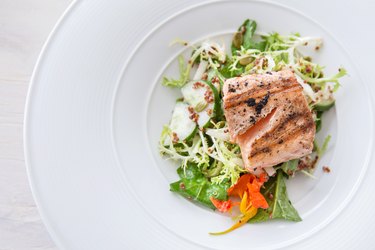
Distributed by Overeaters Anonymous to its members until 1986, the Grey Sheet Diet was a meal plan that received its name from the grey-colored paper on which it was printed. The plan was designed to help control food addiction and promote weight loss. Although Overeaters Anonymous no longer endorses the Grey Sheet Diet, other organizations, including GreySheeters Anonymous, continue to encourage new members to follow the program through sponsors, or members who have adhered to the diet for at least 90 days. The diet may not be a healthy choice for everyone. Talk to your doctor before starting.
Basic Guidelines of the Grey Sheet Diet
Video of the Day
Alternate versions of the Grey Sheet Diet may differ in certain specifics, but the basic plan is high in protein and low in carbohydrates. Followers are instructed to eliminate all sugar and sugary desserts like cake or candy, alcoholic beverages and grain products such as bread, cereal or noodles from their meals. No snacks are allowed between breakfast and lunch or lunch and dinner, and the only thing permitted between meals are diet soda, tea and black coffee. Vitamin supplements — especially ones containing calcium, vitamin E and the B vitamins — are recommended.
Video of the Day
Sample Daily Menu
A typical day on the original Grey Sheet Diet supplies around 1,200 calories.
Breakfast consists of a serving of protein and a serving of fruit. This might be two boiled eggs or 1 cup of plain, unsweetened yogurt and 1 cup of strawberries. Lunch is one protein and one vegetable serving along with a small, or "finger," salad consisting of salad greens with no dressing — or three raw vegetables. Four ounces of grilled chicken, 1 cup of cooked broccoli and romaine lettuce would fulfill this criteria. Another protein and vegetable along with a full salad — 2 cups of lettuce or vegetables with 2 tablespoons of dressing — is dinner. Four ounces of beef or fish, 2 ounces of cheese or 8 ounces of milk also count as one protein serving.
Possible Advantages of the Grey Sheet Diet
If you follow the Grey Sheet Diet's guidelines, it's likely that you will lose weight, especially if your regular diet contained plenty of refined carbohydrates, added sugar, processed or fast foods and alcohol. Some dieters may find that the program's precise rules and portion sizes make it easier to follow than other diets that require counting calories, fat grams or points. The diet's emphasis on fresh produce and lean protein can increase your intake of fiber and certain essential vitamins and minerals while decreasing your consumption of saturated fat, trans fats and sodium.
Potential Disadvantages
The strict guidelines that can make the Grey Sheet Diet appealing to some individuals may make it repellent and impossible to stick to for others. Its restriction on grains is in opposition to the U.S. Department of Agriculture's recommendation to eat plenty of whole-grain foods like brown rice, whole-wheat bread, oatmeal or whole-grain pasta each day and may increase the risk of nutrient deficiencies, particularly of B vitamins and minerals like magnesium and selenium. While the diet addresses food intake, it does not encourage other lifestyle changes, like regular exercise, that can have a significant impact on long-term, sustainable weight loss. If a person following the Grey Sheet Diet returns to his previous eating habits, it's possible he will regain all the weight he lost.